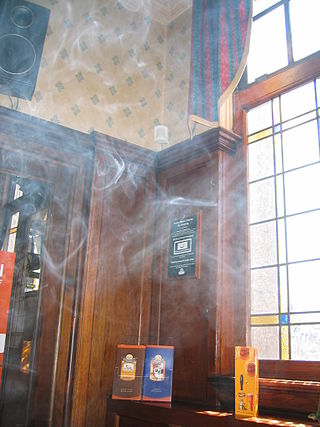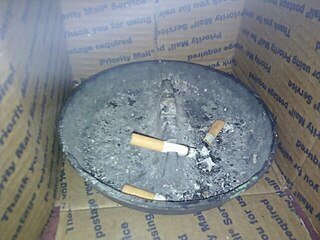Related Research Articles

Smoke is a suspension of airborne particulates and gases emitted when a material undergoes combustion or pyrolysis, together with the quantity of air that is entrained or otherwise mixed into the mass. It is commonly an unwanted by-product of fires, but may also be used for pest control (fumigation), communication, defensive and offensive capabilities in the military, cooking, or smoking. It is used in rituals where incense, sage, or resin is burned to produce a smell for spiritual or magical purposes. It can also be a flavoring agent and preservative.

Indoor air quality (IAQ) is the air quality within and around buildings and structures. IAQ is known to affect the health, comfort, and well-being of building occupants. Poor indoor air quality has been linked to sick building syndrome, reduced productivity, and impaired learning in schools. Common pollutants of indoor air include: secondhand tobacco smoke, air pollutants from indoor combustion, radon, molds and other allergens, carbon monoxide, volatile organic compounds, legionella and other bacteria, asbestos fibers, carbon dioxide, ozone and particulates. Source control, filtration, and the use of ventilation to dilute contaminants are the primary methods for improving indoor air quality.

Environmental health is the branch of public health concerned with all aspects of the natural and built environment affecting human health. In order to effectively control factors that may affect health, the requirements that must be met in order to create a healthy environment must be determined. The major sub-disciplines of environmental health are environmental science, toxicology, environmental epidemiology, and environmental and occupational medicine.

Smoking bans, or smoke-free laws, are public policies, including criminal laws and occupational safety and health regulations, that prohibit tobacco smoking in certain spaces. The spaces most commonly affected by smoking bans are indoor workplaces and buildings open to the public such as restaurants, bars, office buildings, schools, retail stores, hospitals, libraries, transport facilities, and government buildings, in addition to public transport vehicles such as aircraft, buses, watercraft, and trains. However, laws may also prohibit smoking in outdoor areas such as parks, beaches, pedestrian plazas, college and hospital campuses, and within a certain distance from the entrance to a building, and in some cases, private vehicles and multi-unit residences.

Passive smoking is the inhalation of tobacco smoke, called passive smoke, secondhand smoke (SHS) or environmental tobacco smoke (ETS), by individuals other than the active smoker. It occurs when tobacco smoke diffuses into the surrounding atmosphere as an aerosol pollutant, which leads to its inhalation by nearby bystanders within the same environment. Exposure to secondhand tobacco smoke causes many of the same diseases caused by active smoking, although to a lower prevalence due to the reduced concentration of smoke that enters the airway.

Cotinine is an alkaloid found in tobacco and is also the predominant metabolite of nicotine, typically used as a biomarker for exposure to tobacco smoke. Cotinine is currently being studied as a treatment for depression, post-traumatic stress disorder (PTSD), schizophrenia, Alzheimer's disease and Parkinson's disease. Cotinine was developed as an antidepressant as a fumaric acid salt, cotinine fumarate, to be sold under the brand name Scotine, but it was never marketed.

Chain smoking is the practice of smoking several cigarettes in succession, sometimes using the ember of a finishing cigarette to light the next. The term chain smoker often also refers to a person who smokes relatively constantly, though not necessarily chaining each cigarette. The term applies primarily to cigarettes, although it can be used to describe incessant cigar and pipe smoking as well as vaping. It is a common indicator of addiction.
Tar is the name for the resinous, combusted particulate matter made by the burning of tobacco and other plant material in the act of smoking. Tar is toxic and damages the smoker's lungs over time through various biochemical and mechanical processes. Tar also damages the mouth by rotting and blackening teeth, damaging gums, and desensitizing taste buds. Tar includes the majority of mutagenic and carcinogenic agents in tobacco smoke. Polycyclic aromatic hydrocarbons (PAH), for example, are genotoxic and epoxidative.

Sidestream smoke is smoke which goes into the air directly from a burning cigarette, cigar, or smoking pipe. Sidestream smoke is the main component of second-hand smoke (SHS), also known as Environmental Tobacco Smoke (ETS) or passive smoking. The relative quantity of chemical constituents of sidestream smoke are different from those of directly inhaled ("mainstream") smoke, although their chemical composition is similar. Sidestream smoke has been classified as a Class A carcinogen by the U.S. Environmental Protection Agency.

Air pollution is the contamination of air due to the presence of substances called pollutants in the atmosphere that are harmful to the health of humans and other living beings, or cause damage to the climate or to materials. It is also the contamination of the indoor or outdoor environment either by chemical, physical, or biological agents that alters the natural features of the atmosphere. There are many different types of air pollutants, such as gases, particulates, and biological molecules. Air pollution can cause diseases, allergies, and even death to humans; it can also cause harm to other living organisms such as animals and crops, and may damage the natural environment or built environment. Air pollution can be caused by both human activities and natural phenomena.
Third-hand smoke is contamination by tobacco smoke that lingers following the extinguishing of a cigarette, cigar, or other combustible tobacco product. First-hand smoke refers to what is inhaled into the smoker's own lungs, while second-hand smoke is a mixture of exhaled smoke and other substances leaving the smoldering end of the cigarette that enters the atmosphere and can be inhaled by others. Third-hand smoke or "THS" is a neologism coined by a research team from the Dana–Farber/Harvard Cancer Center, where "third-hand" is a reference to the smoking residue on surfaces after "second-hand smoke" has cleared out.
Smoking bans in private vehicles are enacted to protect passengers from secondhand smoke and to increase road traffic safety, e.g. by preventing the driver from being distracted by the act of smoking. Smoking bans in private vehicles are less common than bans extended to public transport or vehicles used during work, like trucks or police cars.
Tobacco smoking during pregnancy causes many detrimental effects on health and reproduction, in addition to the general health effects of tobacco. A number of studies have shown that tobacco use is a significant factor in miscarriages among pregnant smokers, and that it contributes to a number of other threats to the health of the foetus.

Animals are exposed to tobacco smoke and other cigarette by-products through their use as experimental subjects and through contact with smokers, as in the case of pets in houses where smoking takes place.
The Center for Indoor Air Research was a tobacco industry front group established by three American tobacco companies—Philip Morris, R.J. Reynolds, and Lorillard—in Linthicum, Maryland, in 1988. The organization funded research on indoor air pollution, some of which pertained to passive smoking and some of which did not. It also funded research pertaining to causes of lung cancer other than passive smoking, such as diet. The organization disbanded in 1998 as a result of the Tobacco Master Settlement Agreement.
James L. Repace is a Maryland-based biophysicist and scientific consultant known for publishing research on passive smoking.

Tobacco-free college campuses are colleges and universities that have implemented policies prohibiting the use of tobacco products at all indoor and outdoor campus locations. Tobacco is known to be harmful to the health of smokers, bystanders, and the environment. Since this issue was first recognized, colleges have been creating policies for tobacco use on campus in an effort to improve health standards, provide more enjoyable campus conditions, and to reduce the negative environmental effects of tobacco.
Sarah B. Henderson is a senior environmental health scientist at the British Columbia Centre for Disease Control and a public health professor at the University of British Columbia.
Frederica Perera is an American environmental health scientist and the founder of the Columbia Center for Children's Environmental Health at the Columbia University Mailman School of Public Health. Her research career has focused on identifying and preventing harm to children from prenatal and early childhood exposure to environmental chemicals and pollutants. She is internationally recognized for pioneering the field of molecular epidemiology, incorporating molecular techniques into epidemiological studies to measure biologic doses, preclinical responses and susceptibility to toxic exposure.
Anna Louise Hansell is a British physician who is Professor of Environmental Epidemiology and Director of the Centre for Environmental Health and Sustainability at the University of Leicester. During the COVID-19 pandemic, Hansell studied the relationship between pollution and COVID-19.
References
- 1 2 3 4 5 "Katherine Hammond – Prometheus Symphony Orchestra" . Retrieved 2020-03-11.
- 1 2 3 "S. Katharine Hammond, Tobacco Product Regulation". Google Scholar.
- ↑ Gilbert, S. Katharine Hammond (1975). Kinetics and mechanism of the reactions of molybdate and tungstate with catechol derivatives (Thesis). OCLC 10837037.
- ↑ "Technical Advisory Committee". PSE | Physicians, Scientists, and Engineers for Healthy Energy. Retrieved 2020-03-11.
- 1 2 3 4 5 6 7 8 9 10 "03.01.95 - New Faculty Profile: Katharine Hammond". www.berkeley.edu. Retrieved 2020-03-11.
- 1 2 Hammond, S. Katharine.; Leaderer, Brian P. (1987). "A diffusion monitor to measure exposure to passive smoking". Environmental Science & Technology. 21 (5): 494–497. Bibcode:1987EnST...21..494H. doi:10.1021/es00159a012. ISSN 0013-936X. PMID 22296139.
- ↑ Environmental Health Perspectives: Supplements. U.S. Department of Health and Human Services, Public Health Service, National Institutes of Health, National Institute of Environmental Health Sciences. 1993.
- ↑ Hammond, S. Katharine; Emmons, Karen M. (May 2005). "Inmate exposure to secondhand smoke in correctional facilities and the impact of smoking restrictions". Journal of Exposure Science & Environmental Epidemiology. 15 (3): 205–211. doi: 10.1038/sj.jea.7500387 . ISSN 1559-064X. PMID 15187988.
- ↑ "S. Katharine Hammond | Research UC Berkeley". vcresearch.berkeley.edu. Retrieved 2020-03-11.
- ↑ "The Team". Children's Health and Air Pollution Study. Retrieved 2020-03-11.
- 1 2 Plevin, Rebecca (28 January 2014). "Is The Central Valley's Air Pollution Affecting Our Cells And Genes?". www.kvpr.org. Retrieved 2020-03-11.
- ↑ Nadeau, Kari; McDonald-Hyman, Cameron; Noth, Elizabeth M.; Pratt, Boriana; Hammond, S. Katharine; Balmes, John; Tager, Ira (2010-10-01). "Ambient air pollution impairs regulatory T-cell function in asthma". Journal of Allergy and Clinical Immunology. 126 (4): 845–852.e10. doi:10.1016/j.jaci.2010.08.008. ISSN 0091-6749. PMID 20920773.
- ↑ US EPA, ORD (2016-07-26). "NIEHS/EPA Children's Environmental Health Centers Children's Health and Air Pollution Study – San Joaquin Valley (CHAPS-SJV)". US EPA. Retrieved 2020-03-11.
- ↑ "S. Katharine Hammond". Center for Health Journalism. Retrieved 2020-03-11.
- ↑ "Hookah Smoking as Tough on Lungs as Cigarettes". MedicineNet. Archived from the original on 2020-08-09. Retrieved 2020-03-11.